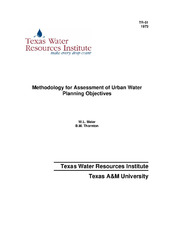| dc.description.abstract | One of the most perplexing problems in the United States today is concerned with providing the public services required in rapidly-expanding urban areas. A substantial portion of the total public service problem in the urban area involves the development, use, and management of water resources.
Through planning, society attempts to define where it is going or should be going and focus its efforts toward achieving well-defined objectives through the efficient allocation of its resources. In urban water planning, the definition of well-defined, consistent objectives is complicated by the institutional structure.
It is characteristic of an urban area for many agencies to be concerned with water resource development, use, and management. These agencies may be federal, state, regional, and/or municipal in jurisdiction and usually have overlapping responsibilities and authority. This governmental "overbite" makes for complex and often inconsistent planning. Additionally, a more informed and concerned general public is currently seeking a greater role in the allocation of available resources.
In any planning problem, it is necessary to define the goals and objectives to be achieved by the plan, select alternatives to be considered, choose planning methodology and develop supporting data, develop and evaluate alternative plans, select an alternative, and implement the selected plan. Previous researchers have attempted to improve planning technology by utilizing operations research and systems analysis techniques in the investigation of alternatives to provide insight in selecting plans which best meet planning objectives. However, these improved planning techniques are effective only if a good definition of the problem and state- ment of the planning objectives are available. Most often the problem definition and statement of planning objectives are the most difficult tasks in the entire planning process. The defini- tion of objectives is complicated by the fact that urban planning problems are most often attacked by interagency groups composed of local, state, and federal agencies.
In this report, procedures are developed whereby precise and consistent urban water planning objectives, reflecting the views of the involved agencies and the general public, may be developed in an equitable and unbiased manner. This is achieved by observing that objective setting procedures are composed of four basic com- ponents: 1 ) techniques for structuring the problem, 2) techniques for eliciting ideas and promoting consensus of opinion, 3) tech- niques for determining the public's attitude toward the objectives, and 4) techniques for providing an inventory of current resources and for estimating future requirements. Objective setting pro- cedures can be generated by the judicious selection in combina- tion of techniques from each of these components.
A specific objective setting procedure, developed for the San Antonio, Texas area, is presented in this report. The procedure is illustrated using an example problem drawn from the study area.
Additionally, opinions of five experts in water planning in the study area are utilized to compare the procedure developed with the objective setting procedures currently in use in the study area. The results of the evaluation unanimously ranked the procedure de- veloped in this research above the currently-used procedures. | en |


